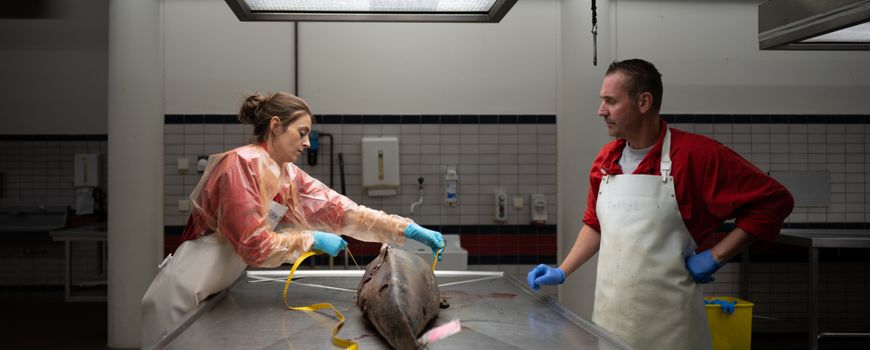The number of dead harbor porpoises was remarkably high, given the annual average of about 600 stranded harbor porpoises on the Dutch coast. Sixteen of the 22 porpoises examined turned out to be adult females. “All harbor porpoises were in a comparable state of decomposition and therefore probably died around the same time,” explains biologist Lonneke IJsseldijk of Utrecht University.
Sudden death is obvious
The porpoises were examined for their physical condition, the presence of parasites and blood samples were taken. This was followed by lab research into the contents of the stomachs and the presence of algae toxins and potentially deadly microorganisms. This shows that the porpoises were generally in fair to good health before their death. IJsseldijk: “They had a healthy fat layer, relatively few parasites were discovered and many of the adult females had recently become pregnant. Sudden death was likely on that basis.”
Empty stomach
Despite their relatively good health, no prey remains were found in the stomachs of eleven porpoises. The rest of the porpoises had only small amounts of food in their stomachs. “So the animals involved in this mass stranding had starved for some time before they died,” says marine biologist Mardik Leopold of Wageningen University & Research. “This is appropriate for a severe and acute course of disease.”
Blood poisoning
The same bacterium was found in more than three quarters of the porpoises examined: Erysipelothrix rhusiopathiae. This is a bacterium that occurs in almost all animal species and that causes spot disease (Erysipeloïd) can cause: an infection known mainly in pigs and turkeys. The disease can also affect reptiles, fish, and humans. In the porpoises, the bacteria appeared to occur in all kinds of organs, this was a blood poisoning.
The porpoises may be infected with Erysipelothrix via infected water, infected fish, or cross-transmission. It is unclear whether and how this could have resulted in large-scale deaths. According to IJsseldijk, this interpretation is difficult: “There are no descriptions in the literature of large-scale deaths as a result of Erysipelothrix-infection, only a few isolated individual cases. We also do not know whether this bacterium normally occurs in harbor porpoises. But the fact that we have not previously found this bacterium in porpoises during an autopsy is certainly striking.”
Exclude options
“All in all, we were able to cross off a lot of possible causes of death through this research,” said Leopold. “For example, we can rule out sudden mass deaths from an underwater explosion, wind farms, climate change or overfishing. However, special weather conditions may have been partly responsible for the massive washing up of the animals, which must have died far at sea.”
However, there are still possibilities. For example, researchers from Erasmus University are still looking at the possible presence of viruses. And a low amount of saxitoxin (STX) has been found in the porpoises: a potent toxin produced by algae that affects the functioning of the nervous system. Due to the poor condition of the stranded harbor porpoises, it is still unclear what the STX concentration was just before death and whether the concentration was high enough to have played a possible role in the mass mortality.
More information
Text: University of Utrecht & Wageningen Marine Research
Photo: Bas Niemans, Utrecht University
– .


